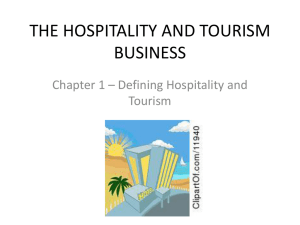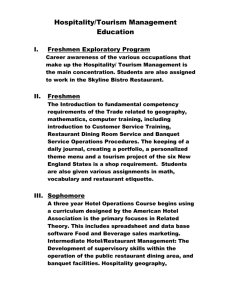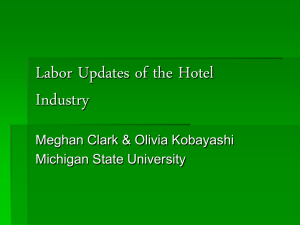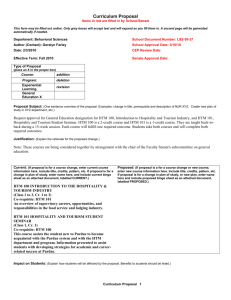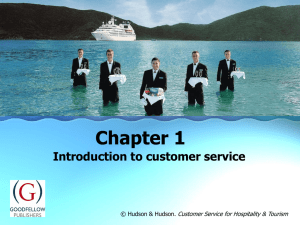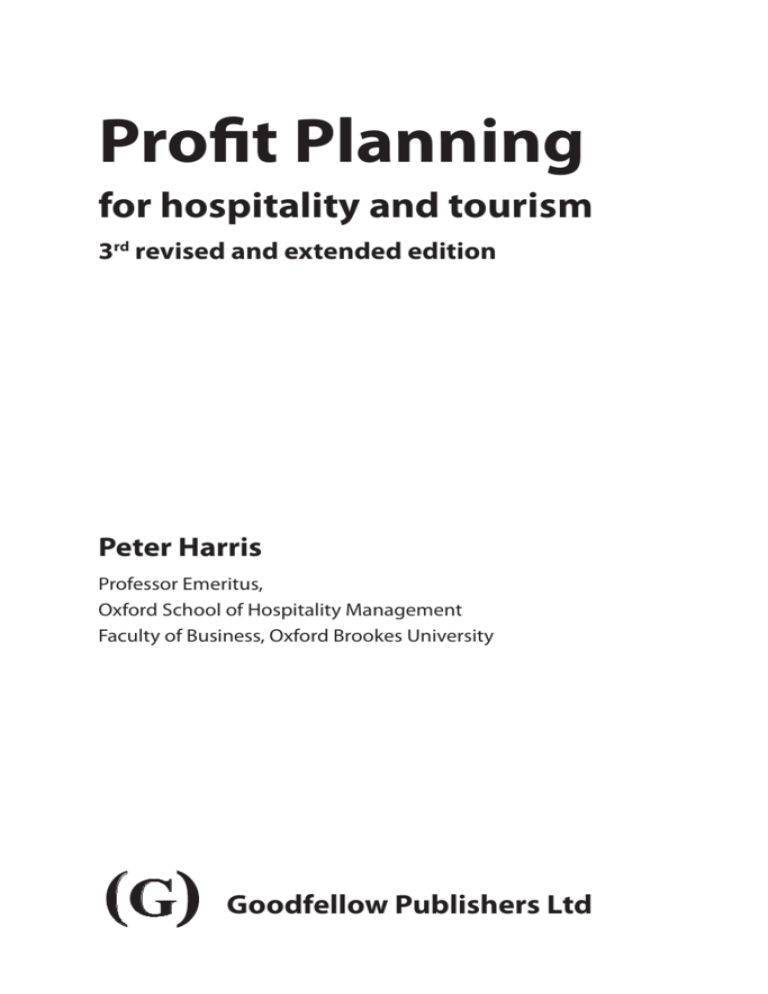
Profit Planning
for hospitality and tourism
3rd revised and extended edition
Peter Harris
Professor Emeritus,
Oxford School of Hospitality Management
Faculty of Business, Oxford Brookes University
(G)
Goodfellow Publishers Ltd
(G)
Published by Goodfellow Publishers Limited, Woodeaton, Oxford, OX3 9TJ
http://www.goodfellowpublishers.com
British Library Cataloguing in Publication Data: a catalogue record for
this title is available from the British Library.
Library of Congress Catalog Card Number: on file.
ISBN: 978-1-908999-62-7
Copyright © Peter Harris 2011, 2013
All rights reserved. The text of this publication, or any part thereof,
may not be reproduced or transmitted in any form or by any means,
electronic or mechanical, including photocopying, recording, storage in
an information retrieval system, or otherwise, without prior permission
of the publisher or under licence from the Copyright Licensing
Agency Limited. Further details of such licences (for reprographic
reproduction) may be obtained from the Copyright Licensing Agency
Limited, of Saffron House, 6–10 Kirby Street, London EC1N 8TS.
Design and typesetting by P.K. McBride, www.macbride.org.uk
Cover design by Cylinder, www.cylindermedia.com
With love to my daughter Samantha ‘Sam’ Kate
and
in memory of my beloved Elaine
Contents
Preface to the third edition
Preface to the third ‘extended’ edition
1
2
3
4
Revisiting hospitality and tourism operations: fresh insights
vii
viii
1
Understand your business and you understand accounting
Hospitality operations
Tourism attraction operations
Features of hospitality and tourism business operations
Connecting accounting into business decisions
1
2
5
6
11
Review of hospitality and tourism financial statements
13
Profit and loss statements
Service industry profit and loss statements
Hotel profit and loss statements
Hotel profit and loss statement (extended) Restaurant profit and loss statements
Visitor attraction profit and loss statements
Balance sheets
Cash flow statements
13
14
15
18
20
21
23
25
Understanding results using ratios
30
Understanding and using ratios
Ratio analysis: a hotel example
Liquidity ratios
Debt management ratios
Asset management ratios
Profitability ratios
Operating ratios
Interpreting results
Relevance of ratios
30
30
32
33
35
38
42
47
49
Comparing and benchmarking performance 50
Bases for comparing operating results
Comparing past (or budgeted) results
Comparative common-size analysis of results
Comparing intra-company results Inter-firm comparison (benchmark reports)
Averages used in industry surveys
50
51
53
55
57
66
iv
5
6
7
8
9
Profit Planning
Practical cost behaviour for decisions: dropping a stone into water
68
Developing profitable business
Creating a profit planning framework
‘Dropping a stone into water’
Practical analysis of cost behaviour
Classifying revenue and expenses
Marginal profit and loss statement 68
68
70
71
75
79
Break-even, profit and loss scenarios
81
Using cost behaviour for CVP analysis
CVP basic calculations: restaurant
CVP (break-even) graph: restaurant
CVP analysis for decisions: café and bakery CVP analysis: hotels
Hotel quick & dirty calculations
CVP analysis for transactions: tourist attraction Engaging with practical CVP techniques
81
81
84
86
92
95
97
103
Cost structure
104
Using CVP analysis to understand our business Cost structure
Cost structure and business orientation
Industry cost structures
Hotel property cost structures
Hotel department cost structures
Hotel property cost structure: limited service
Cost structure and business decision making
Connecting cost structure with decision making
104
105
107
109
111
113
115
117
118
Flexible budgets for planning and control
119
Using CVP analysis for routine planning and control
Budgets for planning
Preparing a flexible budget
Budgets for control
Budgets for control (business mix)
Applying flexible budget techniques
119
119
121
124
128
134
Profit multiplier profile 136
Using CVP analysis to improve profit
What influences (multiplies) profit
Key factors affecting profit
136
136
138
1: Revisiting hospitality and tourism operations v
Profit multiplier profile
Profit sensitivity analysis: visitor attraction
Profit sensitivity analysis results
Market and product orientated businesses
Framework for profit improvement
10 Pricing in hospitality and tourism
Cost-plus pricing
Full cost-plus pricing: hotel average room rate
Direct cost-plus pricing: visitor attraction event
Gross margin pricing: restaurant average spend
Going rate pricing
Contribution margin pricing
Cost structure and pricing decisions
Developing an overall pricing policy
Mark-up and profit
11 Budgets and forecasting
Budgets
The budgeting process
Budget preparation process
Final budget and review process
Forecasting
12 Developing customer profitability analysis
What is customer profitability analysis?
Customer profitability analysis and revenue (yield) management
Understanding activity-based costing
Hotel customer profitability analysis: an example
Customer profitability profile 13 Getting the information we need
Why do we need financial information?
What is information?
Foundation for an information system
Critical success factors approach
Changing information needs
Balanced scorecard
Using information to support decision making
139
139
144
147
148
149
149
152
154
155
160
161
165
166
169
170
170
171
174
181
184
186
186
187
187
190
195
199
199
199
201
202
204
205
207
14 Capital expenditure decisions
208
Discounted cash flow (DCF)
208
vi
Profit Planning
DCF: Net present value (NPV) method
DCF: Internal rate of return (IRR) method
Net present value versus internal rate of return
Cost of capital
210
211
212
213
15 Using computer spreadsheets
216
A brief review of the spreadsheet
Creating a simple financial model
Designing a spreadsheet
Spreadsheet graphics
‘What if?’ analysis tools
Spreadsheet applications
217
218
220
223
224
228
Appendix
Step-by-Step: Quantitative analysis of cost functions in hotels and restaurants at the property level
229
Introduction
Steps for quantitative analysis of cost functions (behaviour)
Step 1 Selecting costs for analysis
Step 2 Identifying cost drivers
Step 3 Collecting data on cost items and cost drivers
Step 4 Plotting the data: restaurant illustration
Step 5 Estimating cost functions
Step 6 Determining the quality of data fit
Step 7 Testing the significance of cost drivers
Step 8 Evaluating cost drivers of estimated cost functions
Simple linear regression: hotel illustration
Multiple linear regression analysis
Quantitative analysis of cost functions in decision making
229
230
230
231
233
233
235
238
244
246
250
254
260
Index
265
Preface to the third edition
The purpose of this book is to provide hospitality and tourism professionals and
students of hospitality and tourism management with a practical guide to the
application of key managerial accounting techniques in planning, controlling
and improving profitability at the business property level – the cutting
edge of routine business decision making. Readership includes practicing
managers, entrepreneurs, accountants and financial controllers engaged in the
hospitality and tourism sectors; particularly those offering rooms and spatialrelated (intangible) services found in hotels and tourist/visitor attractions
and the more product-related (tangible) food and beverage services, found in
restaurant, bistro, café and gastro-pub type establishments.
Many financially-related publications available to managers and accountants
tend to focus on the theoretical areas of accounting and financial management,
whereas this book emphasises how to apply managerial accounting techniques
in practical, day‑to‑day, profit management decisions. The content here
contains concise explanations and illustrations in the context of live business
situations using industry-specific examples. In addition, hotel, restaurant and
visitor attraction examples used in this book can be related and easily adapted
to smaller independent businesses, such as private hotels, bed and breakfast
establishments and pubs, clubs and country inns.
Revisions for this 3rd edition include extensive chapter restructuring and
additional new research and developments applicable to practitioners
operating at, or responsible for, hospitality and tourism-related services at
the property level. Major additions include new chapters on the profit planning
framework, developed and implemented for a number of independent and
international hospitality and tourism organisations; comparing & benchmarking
operating results for monitoring performance; and customer profitability analysis
for identifying customer profiles in terms of profit contributors and lossmakers.
I would like to acknowledge the support given to me by a number of people.
First, colleagues who generously contributed three of the chapters: Cathy
Burgess: Oxford Brookes University, Chapter 11 Budgets and forecasting; Dr Vira
Krakhmal: The Open University, Chapter 12 Developing customer profitability
analysis; Dr Tracy Jones: University of Gloucestershire, Chapter 13 Getting
the information we need. Second, Thanks to Mark Dickens of TRI Hospitality
Consulting for his comments and suggestions on Chapter 4: Comparing and
benchmarking performance. Third, I would like to acknowledge the work of Prof
Richard Kotas, formerly of the University of Surrey, who introduced many
innovations into hospitality accounting including the concepts of ‘business
viii Profit Planning
orientation’ and ‘profit sensitivity analysis’. Also, thanks go to Prof John
O’Connor, Professor Emeritus at Oxford Brookes University, who initially
persuaded me to write this book and to Norah for hours of painstaking
proofreading. Finally, my thanks go to Tim Goodfellow and Sally North of
Goodfellow Publishers for their support and encouragement in preparing this
new revised edition.
My single wish is for readers to find this book an accessible and practical aid
to profit planning.
Peter Harris, 11th July, 2011
Preface to the third ‘extended’ edition
The essence of this additional section to the third extended edition of this
book is to facilitate the introduction of a quantitative approach to analysing,
estimating and predicting operating costs at the sharp end of hotel and
restaurant business activities - the property level. The purpose of the
Appendix is to stimulate experienced, up-and-coming and recently qualified
professionals to explore and complement the typically traditional cost
analysis methods with the inclusion of somewhat more objective analytical
approaches.
As readers will be aware, a major thrust of the content is to encourage and
enable managers and financial controllers to engage with practical marginal
accounting information on a routine, day-to-day basis. The arguments are
powerful to do so, as managers are continually assessing opportunities
and alternatives encompassing pricing decisions, competitive bidding, new
business development and transaction negotiation; all of which are influenced
by the way costs – relevant marginal costs - react to these kinds of decisions.
By repeatedly side-stepping or ignoring the importance of relevant costs
for routine, day-to-day, transactions – where lost margins lie – managers
can unintentionally drift back to the past, evoking the busy fool’s syndrome,
by sleep-walking into driving volume rather than consciously generating
profitable revenue.
Accountants and financial controllers can do more to help managers
understand new and evolving cost relationships in their properties and this
is the primary purpose of the Appendix – the intension is to complement the
content of Chapter 5: Practical cost behaviour for decisions with a step-by-step
approach to using quantitative analysis for cost estimation and prediction, all
possible with the assistance of widely available computer software packages,
such as Microsoft Excel.
Peter Harris, 1st February, 2013


